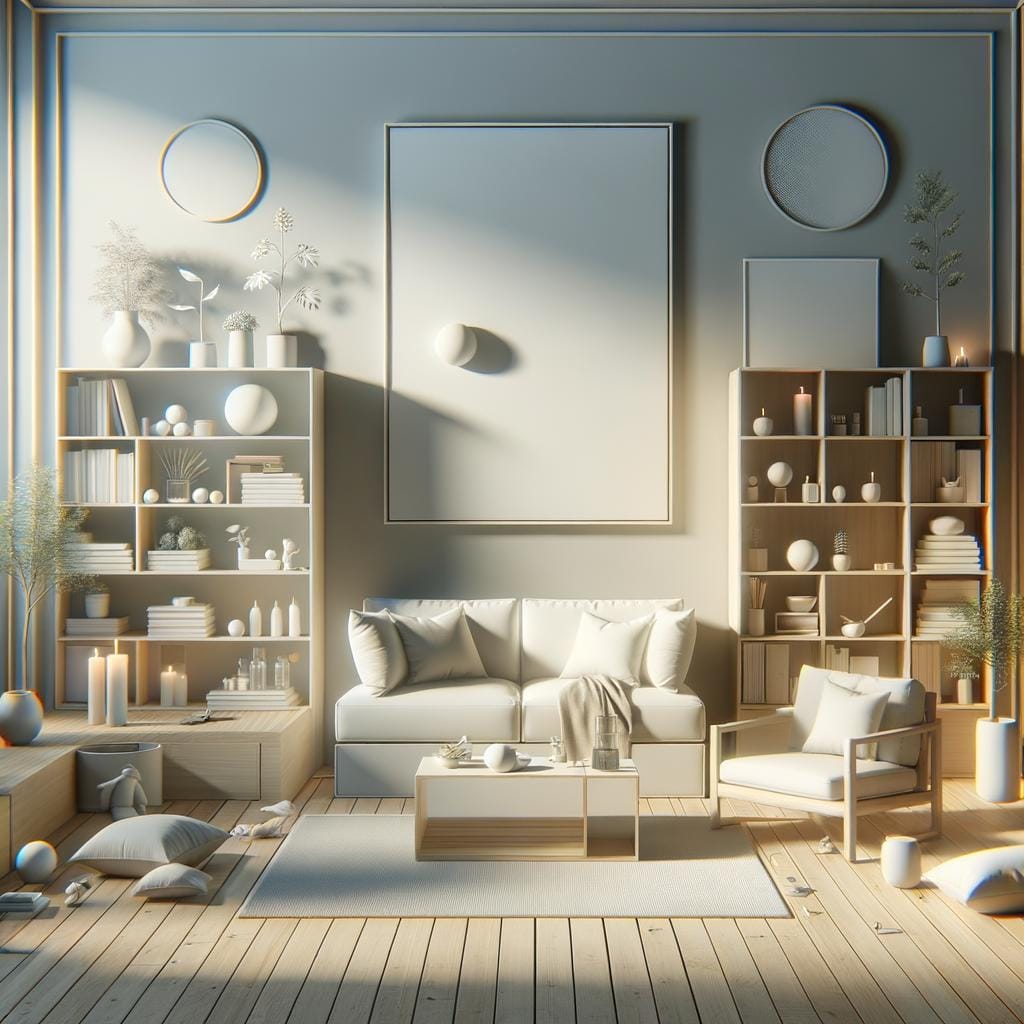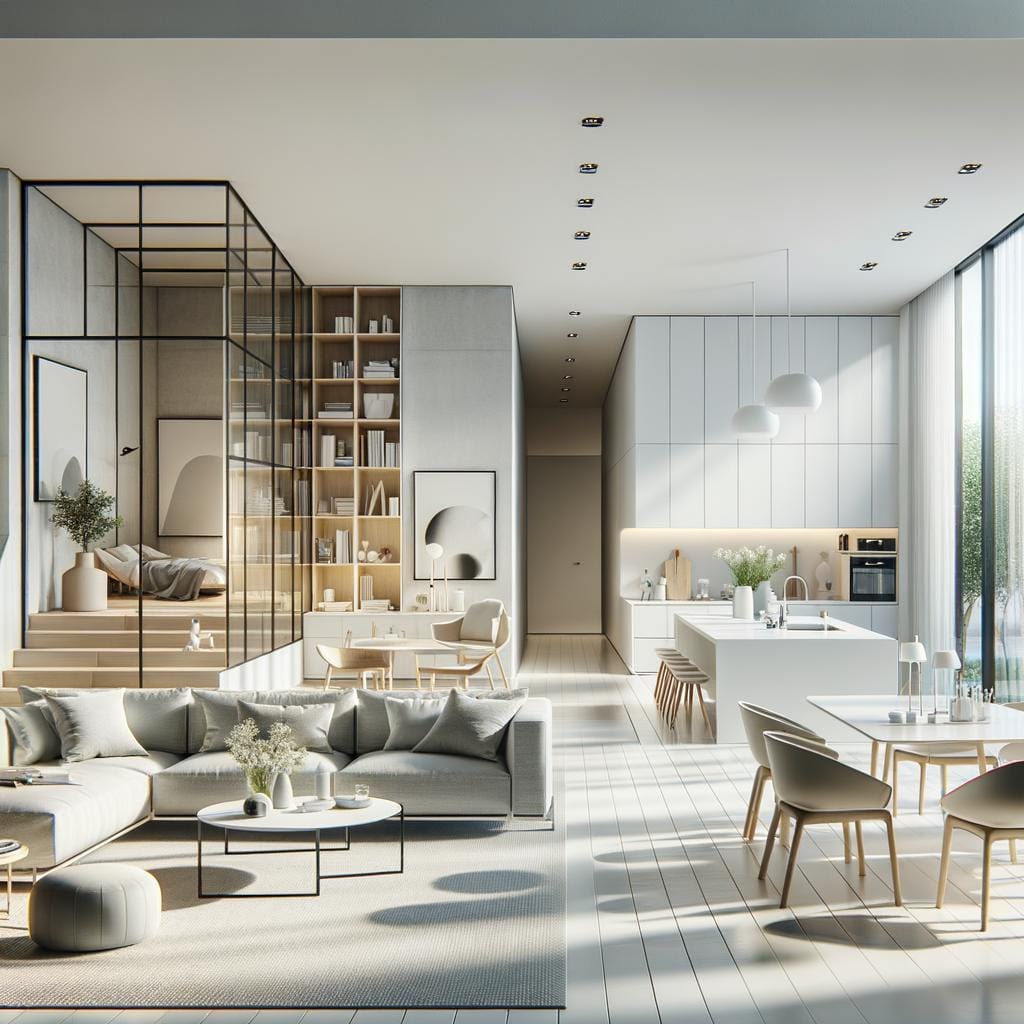Minimalist design principles are a fundamental aspect of creating sleek, clean, and visually appealing aesthetics across various mediums. Embracing the “less is more” mantra, minimalist design focuses on simplicity, functionality, and the use of negative space to achieve a harmonious visual composition.
The roots of minimalist design can be traced back to the early 20th century when artists and designers sought to strip away excess ornamentation and focus on essential elements. This mindset eventually evolved into a distinct design philosophy that has permeated fields such as art, architecture, graphic design, and product packaging.
Key elements of minimalist design principles include a restrained color palette, simple typography, clean lines, and a strategic use of white space. By eliminating clutter and unnecessary embellishments, minimalist design allows for greater emphasis on form, structure, and overall impact. Whether it’s in architecture or graphic design, adhering to these principles can create a sense of calmness and sophistication in the final product.
History of Minimalist Design
Minimalist design principles have a rich history that dates back to the early 20th century. Rooted in the modernist movement, minimalist design emerged as a reaction against the ornate and cluttered designs of previous eras. Influential figures such as Ludwig Mies van der Rohe, known for his famous motto “less is more,” and Dieter Rams, the iconic industrial designer for Braun, championed the idea of simplicity and functionality in design.
Key Elements of Minimalist Design Principles:
- Simplistic shapes and forms: Minimalist design often features clean lines, geometric shapes, and simple silhouettes.
- Limited color palette: A restrained color scheme consisting of neutrals like white, black, gray, and beige is characteristic of minimalist design.
- Functional furniture and decor: Furniture pieces are often designed with a focus on practicality and usability rather than ornamental details.
- Negative space: Embracing white space or negative space is essential in minimalist design to create a sense of calmness and clarity.
- High-quality materials: Minimalist design values quality over quantity, with an emphasis on natural materials like wood, stone, and metal.
The history of minimalist design serves as a foundation for contemporary designers seeking to create visually appealing yet functional spaces. By understanding the origins and key elements of minimalist design principles, designers can effectively incorporate these timeless ideas into their projects. Whether it’s in architecture, interior design, graphic design, web design, or product packaging, minimalism continues to resonate with audiences looking for simplicity and sophistication in today’s fast-paced world.
Key Elements of Minimalist Design Principles
Minimalist design principles are centered around the idea of simplicity, functionality, and minimalism. At its core, minimalist design focuses on stripping away unnecessary elements to create a clean and efficient aesthetic. This approach emphasizes clarity, precision, and order in design. In order to truly embody minimalist design principles, designers must adhere to certain key elements that define this style.
Less Is More
One of the fundamental principles of minimalist design is the concept of “less is more.” This means that each element in the design serves a purpose and contributes to the overall visual impact. By removing clutter and unnecessary embellishments, minimalist design communicates a sense of elegance and sophistication. Every detail is carefully considered to ensure that nothing distracts from the essential message or function.
Clean Lines and Simple Forms
Minimalist design often features clean lines and simple forms that make a strong visual statement. Geometric shapes, straight lines, and basic forms are commonly used to create a sense of balance and harmony in the design. By focusing on these fundamental elements, minimalist designs convey a sense of orderliness and structure. This emphasis on clean lines also helps to create a sense of openness and spaciousness within the design.
Functional Design
Another key element of minimalist design principles is functionality. Every aspect of the design should serve a purpose and enhance usability. This focus on functionality ensures that the end product is not only visually appealing but also practical and user-friendly. Minimalist designers prioritize functionality above all else, creating designs that are both aesthetically pleasing and highly functional. By incorporating these key elements into their work, designers can successfully achieve the timeless appeal of minimalist design.
The Importance of White Space in Minimalist Design
White space, also known as negative space, is a crucial aspect of minimalist design principles. In the world of design, white space refers to the empty or whitespace surrounding elements on a page.
While some may view this empty space as wasted, in minimalist design, it is seen as an essential element that helps create balance and harmony within a layout. The principle of less is more is evident in the strategic use of white space to allow elements to breathe and stand out effectively.
Enhancing Visual Hierarchy
One of the key functions of white space in minimalist design is its ability to enhance visual hierarchy. By providing adequate spacing between elements, designers can guide the viewer’s eye towards the most important information or focal point on a page. This deliberate use of white space helps create a sense of order and clarity, allowing for easy navigation and understanding of content.
Fostering a Sense of Elegance and Simplicity
White space plays a significant role in creating an overall sense of elegance and simplicity in minimalist design. By incorporating ample breathing room around elements, designers are able to achieve a clean and uncluttered aesthetic that exudes sophistication. The judicious use of white space can help eliminate distractions and unnecessary noise, allowing for a more refined and polished visual presentation.
Creating Emphasis and Focus
In addition to improving readability and organization, white space also serves as a powerful tool for creating emphasis and focus in minimalist design. By strategically utilizing empty spaces around key elements such as text or images, designers can draw attention to specific areas and communicate their importance effectively. This technique can help highlight essential information or calls-to-action without overwhelming the viewer with excessive details.
Minimalist Color Palette and Typography
When it comes to minimalist design principles, the color palette and typography play a crucial role in achieving a clean and simple aesthetic. Minimalist design often relies on a limited color scheme, with black, white, and neutral tones being the primary choices. These colors help create a sense of sophistication and elegance while maintaining a sense of simplicity. By using a restrained color palette, designers can focus on the essential elements of their design without unnecessary distractions.
In addition to the color palette, typography also plays a significant role in minimalist design. Sans-serif fonts are commonly used in minimalist design due to their clean and modern appearance. These fonts have simple lines and lack decorative flourishes, aligning perfectly with the minimalist philosophy of simplicity. The choice of typography is essential to ensure that the text complements the overall design aesthetic without overpowering it.
An excellent example of how minimalist color palette and typography can be effectively used is Swiss Style graphic design. This design movement emerged in Switzerland in the 1950s and emphasizes clarity, simplicity, and objectivity in visual communication. Swiss Style designers often use sans-serif fonts like Helvetica or Univers, combined with limited color palettes consisting primarily of black, white, and one or two accent colors. This approach results in visually striking designs that are both timeless and impactful.
| Minimalist Design Elements | Example |
|---|---|
| Limited color palette | Black, white, neutral tones |
| Sans-serif fonts | Helvetica or Univers |
Examples of Minimalist Design in Architecture and Interior Design
Minimalist design principles have gained popularity in the fields of architecture and interior design for their clean, sleek, and uncluttered look. One key aspect of minimalist design in these areas is the emphasis on simplicity and functionality. Architects and interior designers often follow the “less is more” approach, focusing on essential elements while eliminating unnecessary ornamentation. This results in spaces that feel open, organized, and peaceful.
When it comes to architecture, minimalist design can be seen in structures with clean lines, geometric shapes, and a focus on natural light. Buildings designed with minimalist principles often prioritize the use of simple materials such as concrete, glass, and steel. These materials are selected for their durability and timeless appeal, adding to the overall aesthetics of the structure.
In interior design, minimalist principles are evident in spaces that feature a neutral color palette, uncluttered surfaces, and functional furniture pieces. Minimalist interiors often include statement pieces that serve both a practical purpose and act as focal points within the space. By incorporating minimalist design elements such as clean lines, open layouts, and a limited color scheme, architects and interior designers create spaces that evoke a sense of calmness and sophistication.
| Architecture | Interior Design |
|---|---|
| Clean lines | Neutral color palette |
| Geometric shapes | Uncluttered surfaces |
| Natural light | Functional furniture pieces |
Tips for Implementing Minimalist Design Principles in Graphic Design
Minimalist design principles are not just limited to architecture or interior design; they can also be effectively applied in graphic design. By incorporating the fundamental aspects of minimalist design, such as simplicity, clarity, and functionality, graphic designers can create visually appealing and impactful designs that communicate the intended message effectively. Here are some tips for implementing minimalist design principles in graphic design:
- Focus on Simplicity: One of the key principles of minimalist design is simplicity. Avoid cluttering your designs with unnecessary elements and instead, prioritize clean lines, simple shapes, and minimal text. Embrace negative space to allow elements to breathe and create a sense of balance.
- Use a Limited Color Palette: Minimalist design often relies on a limited color palette to create a cohesive and harmonious look. Opt for neutral colors like white, black, gray, or muted tones to convey elegance and sophistication. Use color sparingly to draw attention to specific elements within the design.
- Choose Modern Typography: Selecting the right typography is crucial in minimalist graphic design. Use clean and modern typefaces that are easy to read and complement the overall aesthetic of the design. Avoid using decorative fonts or excessive styling that may detract from the overall simplicity of the composition.
By adhering to these tips and incorporating minimalist design principles into your graphic designs, you can create visually striking and impactful pieces that resonate with your audience. Remember that less is often more in minimalist design, so strive for simplicity, clarity, and functionality in your creations.
Minimalist Design in Web Design
When it comes to web design, incorporating minimalist design principles can lead to a visually appealing and user-friendly website. Minimalist design focuses on simplicity, clean lines, and a decluttered layout. By following these principles, websites can provide a seamless and intuitive user experience while also conveying a sense of sophistication and elegance.
One key element of minimalist design in web design is the use of ample white space. White space, also known as negative space, helps to create a sense of balance and allows important elements on the webpage to stand out. This enhances readability and clarity for visitors navigating the site. Additionally, white space can evoke a feeling of calm and minimalism that aligns with the overall aesthetic.
Incorporating a minimalist color palette and typography is another essential aspect of designing a minimalist website. Opting for a limited color scheme with neutral tones or monochromatic hues can create harmony and cohesion in the design.
Similarly, choosing simple and easy-to-read fonts for headings and body text contributes to the clean and contemporary look associated with minimalist design principles. By maintaining consistency in colors and typography throughout the website, designers can establish a cohesive visual identity that resonates with visitors.
Minimalist Design Principles in Product Design and Packaging
In product design and packaging, minimalist design principles play a crucial role in creating visually appealing and functional products. By adhering to the principles of simplicity, functionality, and clarity, designers can craft products that stand out in today’s cluttered market.
One key element of minimalist design in product design and packaging is the focus on essential features and eliminating unnecessary elements. This approach not only creates a clean and streamlined look but also enhances the user experience by emphasizing usability and functionality. In addition, minimalist design principles often prioritize high-quality materials and craftsmanship, resulting in products that are both aesthetically pleasing and durable.
When it comes to packaging, minimalism can help communicate a brand’s values and identity effectively. By using subtle colors, simple typography, and clean lines, designers can create packaging that conveys sophistication and elegance. Minimalist packaging also tends to be more sustainable as it often involves using less material and reducing waste, reflecting consumers’ growing preference for eco-friendly products.
Conclusion
In conclusion, the enduring appeal of minimalist design principles lies in its ability to strip away the unnecessary and focus on what truly matters. By emphasizing simplicity, clarity, and functionality, minimalist design has stood the test of time and continues to influence various fields such as architecture, interior design, graphic design, web design, product design, and packaging. The elegance and efficiency that minimalist design embodies have made it a timeless trend that resonates with individuals seeking a refined aesthetic.
The use of white space in minimalist design not only promotes visual harmony but also allows for better readability and comprehension. This intentional use of negative space creates a sense of balance and breathing room within a composition, drawing attention to key elements while eliminating distractions. Likewise, the choice of a minimal color palette and typography in minimalist design helps convey a sense of sophistication and modernity without overwhelming the viewer.
Whether it’s the clean lines of contemporary buildings or the sleek interfaces of digital platforms, minimalist design continues to inspire creativity and innovation across various industries. As designers strive to create impactful visuals that communicate effectively, embracing minimalist design principles can help achieve a harmonious blend of form and function. By adhering to the fundamental aspects of simplicity, minimalism will remain a timeless approach that transcends passing trends in favor of lasting elegance and refinement.
Frequently Asked Questions
What Are the Characteristics of Minimalist Design?
Minimalist design is characterized by simplicity, clean lines, and a focus on functionality. It involves using only essential elements, avoiding clutter or excess decoration. Minimalist designs often feature neutral colors, geometric shapes, and a sense of openness.
What Is Minimalist Design Principles?
The principles of minimalist design revolve around the idea of less is more. This means stripping down a design to its core essentials, eliminating any unnecessary elements that do not serve a specific purpose. Minimalist design principles emphasize clarity, functionality, and an uncluttered aesthetic.
What Is the Minimal Design Theory?
Minimal design theory stems from the belief that simplicity and minimalism can lead to better usability and user experience in various products and environments. By removing unnecessary distractions and focusing on essential components, minimal design theory aims to create designs that are intuitive, efficient, and visually appealing.
It highlights the importance of thoughtful choices in design elements to achieve maximum impact with minimal means.

Hello, I’m April Denton, your go-to expert for all things home decluttering and organization. With over a decade of experience helping individuals transform their living spaces into serene, clutter-free sanctuaries, I am passionate about the life-changing benefits of decluttering. My journey into the world of organization began out of necessity, juggling a busy career and a bustling household. I quickly realized that a well-organized home was the key to a more balanced, stress-free life.





